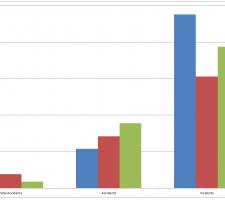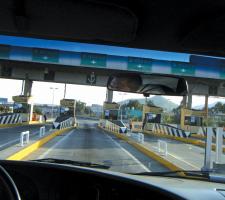
Ana Maria de la Parra
*Ana Maria de la Parra introduces the new external road operation supervisors and fatal accident appraisers who could make a vital contribution to improving the efficiency and safety of highways in middle-income countries like Mexico
Sometimes it is difficult to pin down the perception of a country like Mexico in the popular international mindset. Visitors travelling to Mexico City for the first time are often amazed by its size. They are also frequently taken aback by how unexpectedly advanced it is in terms of providing a comprehensive range of services and amenities for its burgeoning population while managing to keep its culture and special ‘magic’ virtually intact.In stark contrast, there are some aspects of Mexico, including notably the gap between the rich and the poor, which continue to lag behind in the global development stakes. This is to such an extent that outside observers may often wonder how the country can hope to overcome such a wide and daunting array of conflicting issues and priorities. In this respect, Mexico shares many of the transitional challenges facing other countries classified as ‘middle-income’ economies by the
A domain that particularly illustrates the clash between the two visions of the country is that of infrastructure. On the one hand, Mexico boasts some 355,000km of roads that exceed almost all Latin American norms and expectations. Regrettably, on the other hand, performance does not always match the qualitative levels that should be anticipated from such roads, leaving considerable scope for service improvement. Tragically, this state of affairs also impacts on the safety of the roads, which currently account for in the region of 16,000 to 24,000 deaths/year.
It is not possible to give a precise number for the fatalities due to the lack of reliable information, which further demonstrates the dilemmas currently facing the Federal Government with respect to the management of its infrastructure. Apart from a lack of data and standardised procedures, there are many issues and imperatives that need to be simultaneously addressed. As a result it becomes virtually impossible for the relevant officials to keep pace with the status of each highway so as to exercise their authority fully. This in turn undermines due governance.
For these reasons, towards the end of 2008, the Federal Government, in conjunction with private consultants, created the new entities of external road operation supervisor (SEO) and fatal accident appraiser (DAG) to help address the situation. Their roles are complementary and, drawing a parallel with the world of business, can be compared to those of an accountant and tax auditor respectively.
While the SEO works on any kind of incident, the intervention of the DAG is limited to fatal accidents. When these occur, the DAG works in parallel with the SEO to generate a comprehensive safety audit report. The DAG highlights non-conformities with respect to the given road conditions that must be corrected by the concessionaire within a delay of six months. As human lives are implicated, the report of the DAG carries particular weight in this respect.
In December 2009, the first of these new entities took up their duties on a Mexican highway. These people effectively work as the ’eyes’ of the government on the road, as well as mediators between the government and the concessionaire ensuring due performance of the concession contract. In order to assure neutrality, they were assigned by the Roads Authority but paid by the Concessionaire. The full scope of the new entities had yet to be fully defined.
In July 2010, I began working with my father, Alfonso de la Parra (a member of the
Since we were unaware of any previous models for such activity, it was up to the SEO team to define both the methodologies to be adopted and the goals to be attained. From day one, the SEO started gathering information on the highway so as to constitute a thorough inventory of the prevailing infrastructure, including aspects such as an Intelligent Transportation System (ITS), toll systems, quality management systems, environment quality systems, maintenance and budget, as well as other specific issues like emergency response.
At this stage, the SEO’s main concern was to work with the concessionaire on the development of improved data acquisition methods in order to provide both sides with a clearer and more comprehensive idea of the in situ realities and the status of highway operation. This process was complemented by a number of targeted activities ranging from follow up with respect to ITS installation to, among a host of other initiatives, the implementation of training courses and maintenance programmes.
It took six months of coordination work between the SEO and the concessionaire to start obtaining data in a useable format, and in accordance with relevant criteria, to back up the monthly reports on road conditions made by the SEO supervisors as a basis for making better, more informed, decisions. With respect to road safety, the supervisors performed specialised audits at each incident area. These focused on identifying risk factors that contributed, actually or potentially, to causing each given accident. In addition, the audit reports provided pertinent information on the efficacy or otherwise of ITS warning systems, insurance, and medical responses. It also highlighted specific indicators such as weather conditions, smoke, or maintenance at the scene, and the number of vehicles in the area at the time of the accident. The concessionaire is under an obligation to mitigate specific risk conditions identified in the report within a maximum delay of six months, and sometimes less if so instructed by the relevant authority.
In this way, the authority is able to supplement – in the context of a practical monitoring and follow-up process – its knowledge base of key issues affecting the given highway. As a result, it is better equipped to coordinate with the concessionaire regarding decisions and strategies that could avoid reoccurrence of typical accident scenarios, as well as generally make the highway safer.
The availability of thorough monthly reports showing the status of the highway, and highlighting key imperatives on an on-going basis, also helps improve the efficiency of road maintenance.
By analysing incident data and causality, the SEO is able to work with the concessionaire on prioritising issues, and reassigning maintenance budgets accordingly, so as to give preference to remedying clearly identified ‘hot spots’. This exercise was first undertaken for the 2012 maintenance programme on our highway and, thanks to the targeted approach adopted, not a single extra peso had to be added to the budget.
Moreover, the work of the SEO gave the authority an invaluable new perspective regarding the precise status of the road. This assisted relations with the concessionaire, not least in terms of enabling the authority to assess due performance of the programme, and the attainment of agreed goals, by reference to the latest detailed information and specialist insights. All of this was achieved virtually without the officials having to leave the office. Such dynamic coordination led last year to a 50% overall reduction in fatal accidents, compared to the levels for each of the two previous years. In order to build on this encouraging progress, efforts over the next 12 months will focus on further identifying fatal accident risk conditions, with a view to reducing deaths and injuries in those remaining high incident areas where the average figures have regrettably remained stable or shown less of a decline.
The fledgling SEO has been able to achieve major gains in its first three years of operation. And there are many more new ideas and applications still in the pipeline, notably in the domains of ITS and road safety. Already, the SEO has demonstrated its strong potential as an instrument for enhancing governance and facilitating constructive relations between the authorities and concessionaires. In this respect, it has been shown to foster a dynamic and consultative decision-making process – one that also involves and engages the most important of all stakeholders: the road users themselves.
The path has not always been easy. Every scheme that changes the way a company operates, or generates a cultural shift, is bound to be met at first with a certain amount of apprehension, and the SEO has proved no exception.
Once, however, the tools and services provided by the SEO and DAG proved their worth in terms of enabling safer and more efficient road operation, the initial resistance gradually subsided and evolved into acceptance and cooperation from all sides.
The challenge now is to meet growing demand and expectations as more and more areas and authorities seek to benefit from SEO and DAG mechanisms; and to also pose an increasing number of requests for specific analysis and feedback.
The experience to date highlights the potential of the initiative as a framework for achieving first world standard highways, coupled with better governance that could be replicated in other middle-income countries throughout the world.
* Ana María de la Parra, Gerente Técnico
de Supervisión Externa de Operación, by mail to
Website:
Phone: +52 (55) 5595 2628










